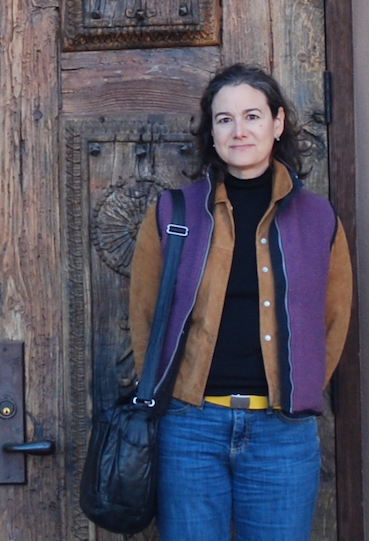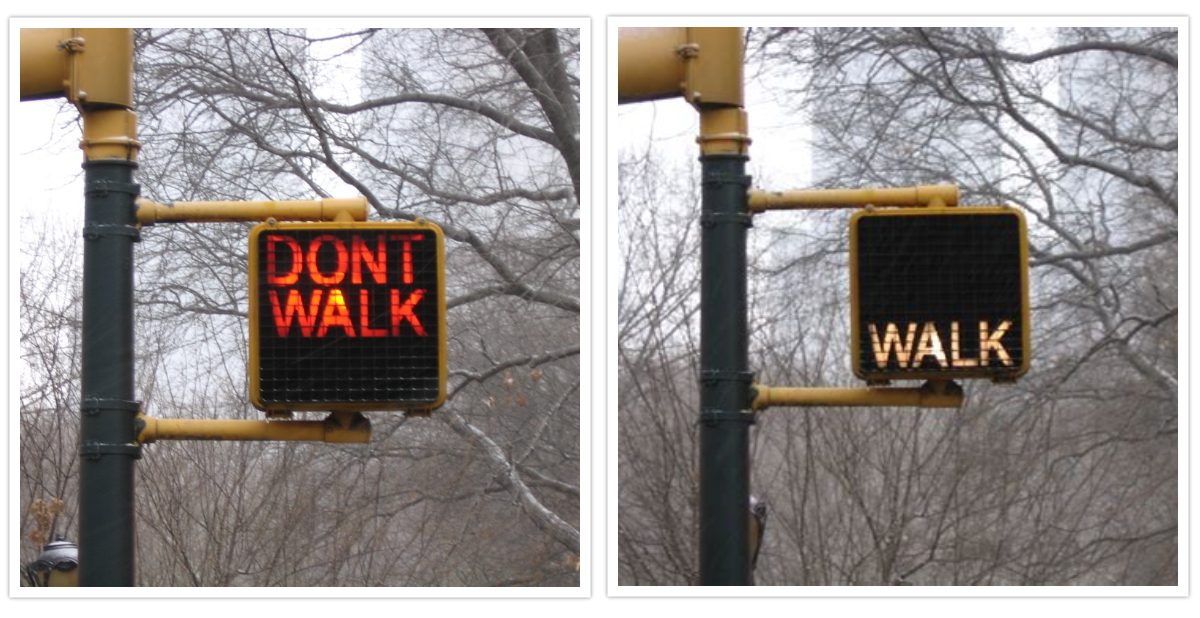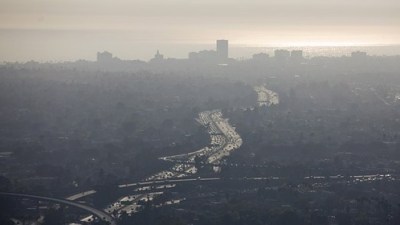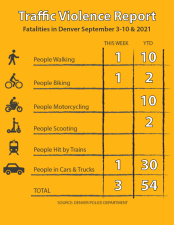Commentary: Best Foot Forward

This guest commentary is by Elizabeth Manus, a writer and editor living in Denver who has worked with the Western Slope Connectivity Project of the Endangered Species Coalition. In New York City, she practiced community advocacy with Landmark West!, Civitas, and the Greenwich Village Society for Historic Preservation. She hopes one day to walk the landscapes of Thomas Hardy’s Wessex novels. She is on LinkedIn and blogs at https://thelasty.blogspot.com.
Dear Denver,
We met on Walk Score. Hello, again. I’m the woman who was looking to move from a mountain town of 450 people to you – you with public transportation and fantastic rec centers and outdoor pools and a large public library system and the symphony and museums and movie theaters and neighborhoods. I was pretty excited.
But, over time my interest in you has flagged. It’s not all you. It’s also me. I’ve discovered that what makes a city is not the place; it’s the people. And the people I need – indeed the fundamental person I am – are pedestrians. Lots and lots of pedestrians, sashaying, passing, laughing, meeting up. You may recall that Walk Score describes my hometown of New York as “the most walkable large city in the US, with 8,175,133 residents.”
The idea of getting up and going outside to fold myself into a car seat and sit a while? Such a turnoff, you have no idea. Even if sitting weren’t the new smoking, I miss giving my arms a workout and carrying my groceries home. I do admit I was happy to have a car of my own for road trips three years ago. But now I think of my car more as a polluting steel canister that endangers me and everybody else and requires inordinate sums of money for unending upkeep. One of my happiest days was the day I took the bus downtown and back. That was the day I felt I’d moved to the City and County of Denver.
By the way, I don’t even think of you as a “city city.” You’re too spread out for that. You’re what I would call a “car city.” You’re not pedestrian-oriented. This works well for those who view you as a sprawling storage locker/staging ground studded with marijuana dispensaries and craft beer, because real life begins at a ski slope or trailhead a hundred miles from the Tattered Cover. For such people, the mountains are calling, and they must go. When they get there, many of them walk for hours.
What about we who remain in the city?
Some days I wonder: What if Denver planners, designers, and policy wonks began to retrofit the place for pedestrians? How might they begin to get their arms around that idea, that kind of public value? First they’d have to distract the entrenched local interests with something like an all-you-can-eat buffet.
Then they could discuss Smart Growth America’s 2021 Dangerous By Design report, which, in lamenting the deaths of pedestrians, partly states:
We must do more… to protect older adults, Black or African American, and American Indian or Alaska Native people walking, and people walking in lower income areas. (page 6)
Policymakers have disregarded this problem for too long and failed to change how we fund, design, operate, maintain, and measure the success of our roads. They have failed to make vehicles safer for people walking. Despite what they claim about safety, they continue to prioritize moving cars at high speeds. (page 29)
I must say, cars moving at high speed have never impressed me. I’m partial to 15 mph speed zones. After living in the mountains, I identify with beings who move at the speed of blood — especially wild animals. Whatever helps to keep me within an orbit of shared experience with them, I want that – not just because this world is their world as much as it is ours, but because I don’t want to live in a box of Homo sapiens’ making. In relative solidarity, then, and also because I’m a visual, tactile person, I deliberately favor the terrestrial life: walking instead of driving; real metal keys instead of electronic fobs, whenever possible; paper checks and autopay; and my Filofax instead of online calendars.
Denver, are you a lobbyist for the auto industry? I wonder. Other days – like the day I filled out a citizen’s survey about Civic Center Next 100: Park & Bannock Street Concept Design, as part of the City of Denver’s Outdoor Downtown planning process – I dream a little dream for you that features much more foot traffic and bicycles. This is the Mile High City, no? You should be walking on sunshine.
Until that day becomes a reality, here’s my personal primer to being a walker in the city.
Best foot forward,
Liz
The Best Foot Forward Primer
Inspired by the book Going into Town: A Love Letter to New York by Roz Chast
My standpoint
I’ve been an urban pedestrian for most of my life. If I’ve lived in other cities and left them, it’s because to me they were cities in name only. A city is for pedestrians. It’s not for parking lots or stacks of garages. It’s not for stadiums or freeways. A city is for walking.
Walking distance and blocks
Walkers and drivers have different lingo. City pedestrians do not think in terms of miles or the compass. Generally speaking, they think in terms of what is known as “walking distance” and “blocks.” “Blocks” are finite lengths of sidewalk, typically four inches thick, running alongside a street. In a city, pedestrians don’t say, “Go east for a half-mile.” Instead they say, “Go two blocks up, take a left at ___ and it’s another three blocks to ___.”
Walkability
This is a triple-layer cake kind of criterion. Walkability doesn’t only mean that sidewalks and crosswalks exist, or that crossing signals last long enough, or that sidewalks are wide enough to comfortably accommodate you and your dog heading one way and a couple with a stroller, a toddler, and a person with a rollator coming the other. Walkable neighborhoods are ones that are interesting to walk around. They give you something to look at or interact with, or both. Walkable neighborhoods offer anything from a playground and a community garden to murals, shops, and historic homes. They also have trash cans and mail boxes, and, with luck, trees. Tennyson Street in Highland is an example of a walkable streetscape. So is Cherry Creek (minus the mall – malls are for the walking dead). But, it’s important to keep in mind that walkable neighborhoods are ones with people walking in them. People enact the drama of the street. Then they walk home.
How to walk outside
Exit the front door of your dwelling place and mentally prepare to execute the exact same kind of motions you use inside your own home. Then, like a surfer sliding onto a wave, begin moving forward. Remain vertical. If there are other people on the sidewalk, make sure you don’t jostle them. If you recognize neighbors along the way, acknowledge them. If you find yourself on a crowded sidewalk, there might be weavers salmoning against the flow of traffic. Any which way, people with common sense walk with all their senses situationally attuned. Their eyes see what’s around them, and their ears – or one ear, anyway – take in aural clues as to what’s happening in the streetscape.
Poetry in motion
Situationally attuned pedestrians can’t help but develop a poet’s eye over time. We foot travelers notice everything: sidewalk stamps, passing butterflies, moss breaking through pavement, snails to save from being washed into the path of an oncoming car during a summer monsoon.
Good impressions
Wait! What the hey is a sidewalk stamp or plaque? In Denver it’s a lagniappe, a bonus of living in a city that is relatively young. Congress Park and Cheesman Park have quite a few of these. Here are some snapshots of them.

Freestanding
You think twice about stopping into the ice cream shop you just passed. Either by lifting your feet or pivoting on the ball of your foot or your heel, swivel around until you complete a 180-degree turn. Now you’re ready to ramble. This also works if you are going the wrong way and realize it suddenly. Here is ease. Here is freedom of movement. That’s right: no illegal U-turn, no three-point turn, no driving around the block. Ta-da! You’re welcome.
Step up, step in
An estimated 250 miles of Denver streets don’t have sidewalks. Yet, to my surprise, the Walk Score website (on April 17, 2021) describes Denver as “the 16th most walkable large city in the US with 600,158 residents.” With a Walk Score of 61 “Denver is Somewhat Walkable,” meaning, in site-speak, “Some errands can be accomplished on foot.” Hmm.
To my eyes, Denver deserves a score of 35 because disregard for pedestrian patterns and sensibilities is ubiquitous here. Miles of high-speed streets have too few crosswalks and crossing signals. Speed limits along avenues in residential neighborhoods are not enforced. So-called walkable neighborhoods have laughably narrow sidewalks, and they are often in hair-raising states of disrepair.
As we continue with our pandemic year of living differently, perhaps now is a good time to increase your awareness of people on foot. There are plenty of ways to take action – for example, by attending a City Council meeting, or by contacting your district’s member of the Mayor’s Pedestrian Advisory Committee to find out about sidewalk policy. You could get involved with a project of the Denver Streets Partnership, a coalition advocating for people-friendly public spaces.
Personally, I would begin with a more basic approach. I suggest that, over the next month, you adjust your antennae to sense pedestrians on the move. Observe their street-crossing options and choices, whether you’re on Speer or in RiNo. Make mental notes about the condition of the surfaces they use. Notice how drivers of cars and other vehicles behave towards pedestrians. Before you go to sleep each day, imagine yourself into the body of one of the pedestrians you observed. What’s it like to be in their shoes?



